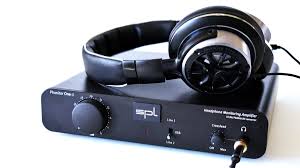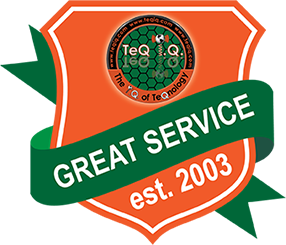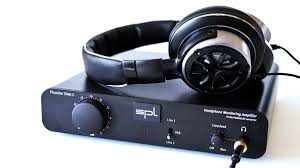
"Share this Info and Help a Friend"
AD: We want to be your IT and Technology Provider!
Special International Travel Hotspot and Phone Plans.
No Contract Prices, IT, Cellphone, TV, VOD, Phone, Internet.
"You have Nothing to Lose But your Higher Bill"
https://www.teqiq.com/
Like most people, you probably don’t think twice about plugging your headphones directly into the headphone jack of your computer, laptop or smartphone. For the typical pair of mobile headphones this is acceptable, but as you move up the ladder of headphone quality the output from these devices just doesn’t cut the mustard.
If you want quality audio and expect to be blown away, then a headphone amp might be just what you need.
What Is a Headphone Amp?
In essence any audio amplifier is a device that takes a signal which has relatively low strength and reproduces it at a higher power level. We perceive that higher power level as more loudness.
However, not all amplifiers are equal. A good amplifier does more than simply make your music louder. It will also try to preserve the detail and intent of the original signal. Good amplifiers won’t add noise and will work to clean up issues with the original audio.
There are many different approaches to the design of amplifiers and headphone amps are no different.
For example, some only accept an analog input, which means your device’s own internal amp and audio hardware will have the first go at the sound.
If your audio source is analog (e.g. vinyl records) then this isn’t a problem for the headphone amplifier, because you avoid unnecessary analog to digital conversion.
Then, there are headphone amps that have their own DAC (Digital to Analogue Converter) which connects to your computer via USB. These amplifiers have complete control over the audio, since they only receive digital audio data and handle every stage involved in getting it out of your headphone speakers and into your ears.
Many headphone amplifiers offer both types of input, which can be useful given that many mobile devices won’t work with an external USB DAC.
Why Do We Need Headphone Amps?
Whether in headphones or on a desk, speakers need electrical power to create the air vibrations we perceive as sound. If there isn’t enough energy on tap, then resulting audio is weak and quiet. As a result, it lacks detail and punch.
The internal amplifiers in smartphones and computer sound cards compromise. They have to fit into an incredibly tiny amount of space, shared with other components. In battery powered devices, amps have to be carefully designed and balanced so that they aren’t power hogs. Honestly, there’s a lot to admire about these devices, which manage to offer usable, pleasing audio despite seemingly impossible engineering obstacles.
It also helps that most headphones these days are explicitly designed to work with smartphones and other similar devices, so they are loud enough. This has to do with the sensitivity of a given headphone set.
Headphones designed for mobile device use have a high level of sensitivity, which essentially means that they can achieve a given level of loudness using very little power. The downside of this is that high sensitivity levels tend to muddy audio, compromising the integrity of the sound.
It’s not such a big deal if you’re listening to compressed streaming music while out for a morning jog, but for intentional listening the problems are there if you pay attention.
To fix this problem you have to reduce the sensitivity of the headphones, but the less sensitive the phones, the lower the volume you can achieve with the power output of a smartphone or computer.
Which Headphones are Suitable for Amps?
The short answer is that high-impedance headphones need a dedicated headphone amplifier to achieve their full potential.
“Impedance” is the resistance electrical energy encounters as it travels through the headphone wiring on the way to the speakers. Impedance is measured in Ohms and generally high-impedance, low sensitivity headphones have a rating of 25 Ohms and higher. Higher-end headphones tend to have more than 100 Ohms of impedance.
So if your headphones have less than 25 Ohms of impedance, you don’t need an amp, the higher up you go from that number the more crucial an amp becomes.
Bluetooth headphones obviously don’t need an external amplifier because they have one built in, but some Bluetooth headphones also have a wired option. This option commonly bypasses the internal amplifier, so depending on their sensitivity levels an amp could be suitable there as well.
Headphone Amp Types
Internally, there are various ways in which amplifiers can be designed, which are discussed in excruciating detail on audiophile forums. However, for the rest of us there are two main types of headphone amplifier to consider: solid state amplifiers and tube amplifiers.
Solid state amplifiers use nothing but microchips in the chain of components leading to your actual eardrums. It’s all-digital, crisp, and, as some contend, cold. Solid state amplifiers are usually more affordable, durable and compact.
Tube amplifiers hark back to the days before transistors and integrated circuits overtook the audio industry. They are easy to spot thanks to the prominent glass tubes sticking out of the chassis. More expensive ones usually have more tubes, cheaper models tend to make use of solid state components in tandem with analog tubes.
Many audiophiles swear by the warm tone and coloration tubes give to music and sound, but it is very subjective. What’s not so subjective is that tube amps are generally more expensive, fragile and take up more space. The truth is that a good solid-state amp will be fine for most people, but you should sample tube amplifier audio to see if it tickles your fancy.
Headphone Amp Suggestions
So, if you’re set on investing in a quality set of cans and know that you’ll be needing an amp to make the best of it, what should you buy?
We had a look at the best-selling headphone amplifiers on Amazon and found three options which look quite promising for someone looking to dabble in headphone amps. As a bonus, they also represent three distinct categories of headphone amp.
FiiO E10K USB DAC and Headphone Amplifier
The FiiO E10K headphone amp is a very affordable solid-state amp with a clean shell and minimal controls. All you have to do is plug everything in and crank up the volume to a comfortable level.
The E10K only supports digital input via USB, but has a variety of outputs beyond just a headphone jack. If you hook this up to your computer and use it with high-impedance headphones, you should enjoy strong, detailed audio with low levels of noise and distortion.
While it’s not going to make the mouths (ears?) of true audiophiles water, based on the many positive reviews of the amp it’s an affordable and effective upgrade for virtually anyone.
Neoteck Headphone Amplifier
The Neoteck amplifier doesn’t inspire much confidence at first with it’s poorly-translated marketing copy, but it’s a well-reviewed and undeniably interesting product. The big selling point of this amp is that it’s battery powered.
Supporting headphones between 16 and 150 Ohm, there’s a large selection of mid-grade headphones that would benefit from a straightforward amplifier such as this one.
If you’re looking for an amp to take on public transport or to use at work or school, it’s a very affordable option.
LOXJIE P20 Full Balance Tube Amplifier
Finally, we have the Loxjie P20 tube amplifier. It’s one of the cheapest entry-level tube amps we could find and represents a perfect way for you to dip your toes into the signature tube sound before buying something with a more serious price tag.
You get to sample the warmth and smoothness of tubes and decide if it’s for you. Although most buyer’s seem blown away by the amp as a daily driver solution in its own right.
If this tip helps and you would like to donate click on the button. Thanks In Advance.
________________________________________________________________________________________________________
"Fortune Favors, Who Value Time over Money!"
"TeQ I.Q. was the 1st IT Company to Deliver Cloud Solutions since 2003"
Tech issues taking up your Time?
"TeQ I.Q. Makes Your Technology Secure and Protected"
Do you have Tech Frustrations like your Computer, Internet, Phone, Cellphone, Camera, TV, Car?
"Stop Overpaying for Cellphone Service?"
"We Have Special Pricing with T-Mobile!"
LOW Prices at https://www.teqiq.com/tmobile/
"We Take Away Your Tech Frustrations and Give You the Free Time You Deserve!"
Call Robert to ask all your Technology questions.
For Free Consultation Call Now Robert Black at (619) 255-4180 or visit our website https://www.teqiq.com/
Chase Bank and Others Trust TeQ I.Q. with their IT and TeQnology so can you!




